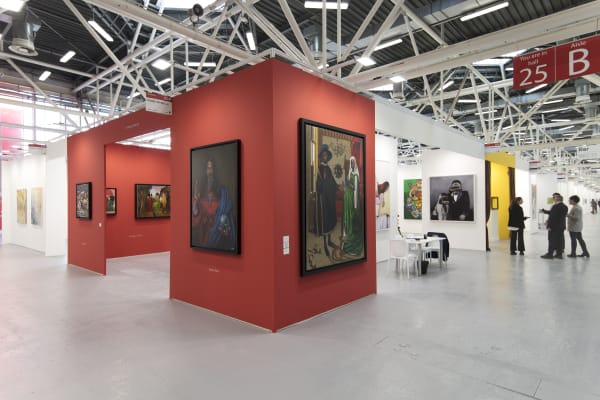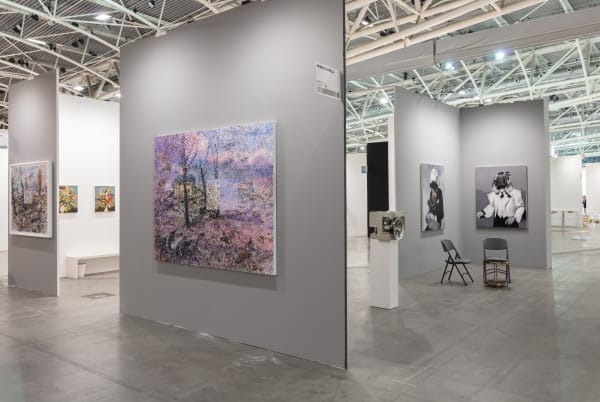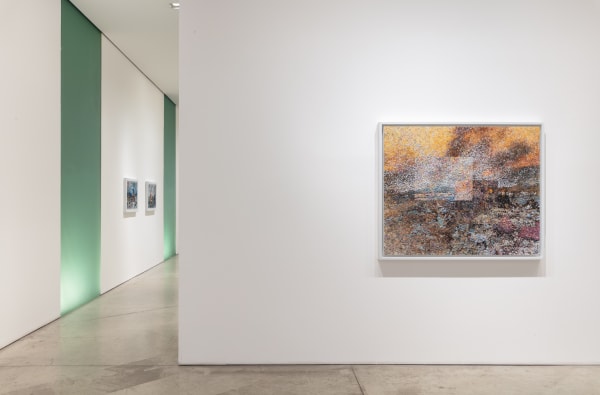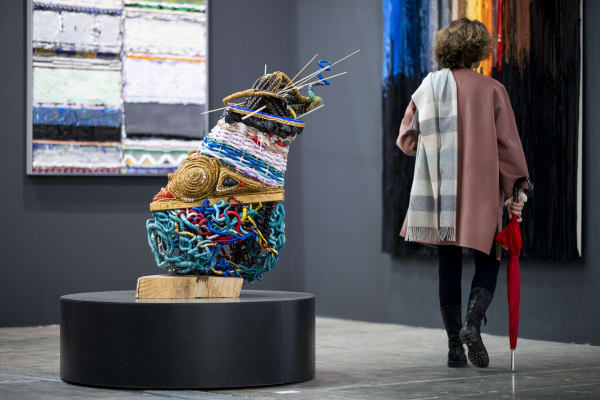-
Biography
WITH HIS PROCESS OF CAPTURING REPRESENTATIONS OF REALITY 'AS PAINTINGS', ARAI TRANSFORMS THE UNITS AND FORMS OF THE USE OF PAINT ITSELF. THE PAINTINGS, CREATED BY DRIPPING PAINT FROM A SYRINGE, MOVE BACK AND FORTH BETWEEN IMAGE AND PHYSICAL MATTER DEPENDING ON THE DISTANCE FROM WHICH THEY ARE VIEWED.
Masayuki Arai was born in 1984 in Wisconsin and currently lives and works in Ibaraki Prefecture, Kanto region, Japan. He completed the Master of Fine Arts course at the Aichi Prefectural University of Fine Arts and Music in 2011 and his works were exhibited at the 2013 Aichi Triennial and the 2014 VOCA. His working process has always involved printing and pasting images collected from the Internet onto a canvas and then expanding them in imaginative ways. This exhibition will present some of Arai's most recent works.In recent years, Arai has started to peel off the photographs that were pasted onto the canvas, leaving the outer imagined, painted parts intact. In repeating this action, pasting new photographs onto it and then drawing and extending the outer parts, the image becomes entangled and layered. With his process of capturing the representations of reality “like paintings” Arai transforms the units and forms of the use of the paint itself. The paintings, created by dripping paint from a syringe, move back and forth between image and physical matter depending on the distance from which they are viewed. This gives a sense of reality to the supposedly fictional images.Arai does not talk much about the photographs used in his work. The viewer is left to imagine what the stripped photographs looked like and from where the scenes depicted in the paintings follow on, without ever knowing their starting point. The absence of the photographs that constituted the starting points for the paintings, and the build- up of the painted depictions that remain on the canvas remind us of the complex relationship between what we accumulate and share every day in the real world, and at the same time highlight their ambiguity. -
fragments of an infinite vision
critical essay on masayuki araiFor centuries, figurative art and abstract art have been considered two parallel, often opposing paths. Yet many artists have demonstrated how blurred this separation is. Masayuki Arai (1984, Japan) fits into this borderline position.A pivotal experience in Arai's approach to his highly original technique is surely that of the Gutai group. Founded in 1954 by Jirō Yoshihara, the Gutai brought a profound break with traditional art and Western abstractionism, giving rise to a new form of dynamic, material, and performative abstraction. Art thus became a physical and vital experience, where matter was to express itself freely in the present moment. This conception of color as an active, sense-generating substance also influenced later artists, including Masayuki Arai, whose work, while distinct in style and method, retains that same material intensity and interpretive openness.Masayuki Arai's style, so singular and fascinating, is the result of a series of fundamental steps that lead to a result deliberately open to the viewer's interpretation. In recent years, the artist has initiated a practice as refined as it is conceptually dense: after pasting photographs on the canvas, he proceeds to gradually remove them, leaving intact the evolutions in the margin, the imagined and painted extensions around the original image. This gesture is not isolated, it is part of a repeated process: new photographs are applied, only to be removed later, while the pictorial contours continue to be expanded and reinterpreted each time. The result is a layered image, where represented reality is intertwined with pictorial invention, blurring the line between document and imagination.Through this practice, Masayuki Arai questions the very nature of painting and its relationship to visual reality. His works arise from an atypical use of paint material: paint is dripped from a syringe, creating an effect of density that varies depending on the distance of the viewer. The only seemingly spontaneous way in which color is applied to canvas, through the use of the syringe, is reminiscent of a new declination of Pollock's action painting. Both artists consider color to be the main element of an artwork: depending on the gesture with which the artist relates to it, a different outcome occurs each time. Hence the randomness resulting from the power of the American artist's gestures, and on the other hand, the study and guidance that Masayuki Arai provides in his own approach to color. Moreover, the use of paint cast in irregular layers creates a three-dimensionality in the work: the lines and colors acquire a physical depth that defies the traditional perception of painting. This textural effect not only makes the work more tangible, but also invites the viewer to interact with it from different angles. The surface of the canvas, transformed into a dynamic landscape of matter, becomes a meeting point between the visible and the invisible, the recognizable and the unrecognizable.His art does not stop at the visible surface, but expands in depth, as if each work were a fragment of a larger, incomplete and continuously developing image. This effect of infinite extension is not only an aesthetic aspect, but becomes a metaphor for the continuity of human perception and thought, which is never limited to a single moment, but is in constant movement, evolution and reinterpretation. His works thus become imaginary landscapes that branch out beyond the edge of the canvas, engaging the viewer in an experience that goes beyond mere visual observation. Just as thought is never limited to the surface, but is constantly in motion, full of facets, conflicting ideas and complex emotions, his works also reflect this fluidity.This idea of cognitive and emotional dynamism is underscored by Arai's very approach to painting, which does not fix the image, but leaves room for the unpredictability of gesture and material.From a distance, the image appears compact, almost photographic: some visual traces hint at figuration, suggesting the presence of a horizon. This element, never rendered explicitly, is charged with meaning when considered in the light of Japanese aesthetics, in which the horizon does not represent a stable or definitive boundary, as is often the case in Western tradition, but rather a mobile, open threshold that changes according to perception, time, and light. In the Japanese vision, the horizon is a place of suspension and possibility, where the visible and invisible intertwine, elements that are also central to Arai's poetics.Approaching the work, however, this illusion dissolves and gives way to raw material. In this way, the artist reverses the traditional modes of painting, transforming it into a language that oscillates between illusion and tangibility.Using a chromatic approach that recalls certain optical logics of Pointillism and Divisionism, both of which are based on the use of pure colors and the interpretation of light, Masayuki Arai reworks these suggestions in a contemporary key, returning images that are both concrete and elusive, recognizable and ambiguous.Significantly, Masayuki Arai does not show the photographs he uses. He does not even describe them in words. He offers no indication of their original content or their provenance. This silence forces the viewer to confront the work directly: one is confronted with canvases that seem to continue from images never seen, from visual traces now erased. The absence of the photographic starting points - removed, but whose emptiness continues to be felt - contrasts with the persistence of the painted forms, suggesting a broader reflection on how we store and share images in our everyday lives. The absence of explicit narrative references leaves the viewer with the task - and the freedom - to interpret the work with his or her own imagination. In this way, the artist turns the audience into co-authors through an active process of interpretation, making each viewing a unique, personal, unrepeatable act. The viewer is pushed to come to terms with what he or she sees, confronting his or her own visual experiences, memories and memory, both personal and collective. Each work, therefore, becomes a kind of psychological mirror reflecting not only the reality of the artist, but also that of the viewer.The traces left on the canvas evoke feelings, past experiences and perhaps even hidden symbols that are intertwined with one's personal history or that of the art itself. This makes each encounter with the work a unique experience, where viewing becomes an intimate and profound reflection on memory and how we construct our perception of the world.Masayuki Arai's art is thus a mental place where we move through intuitions, memories and recollections.In this dialectic between accumulation and erasure, between visible and invisible, Masayuki Arai emphasizes the ambiguity of contemporary visual memory. His works thus become metaphors for the complexity of experience, where what we remember or think we see is always partial, layered, and inevitably manipulated by time and our gaze.- Carolina Fieramosca -
Exhibitions
-
Works
-
Bibliography
Masayuki Arai CV
Born in 1984 in Wisconsin (Japan).
EXHIBITIONS
Solo Show
2025
Like Paintings, Primo Marella Gallery, Milano, Italy
2023
Like Paintings 005, Ginza Tsutaya Bookstore Art Wall, Tokyo, Japan
Like Paintings, Primo Marella Gallery, Lugano, Switzerland
2022
Like paintings, un petit garage, Tokyo, Japan
2021
Like paintings, STANDING PINE, Aichi, Japan
2019
Distorted Horizon, STANDING PINE, Aichi, Japan
2016
Vanilla:, STANDING PINE, Aichi, Japan
2011
Picture picture, YEBISU ART LABO, Aichi, Japan
Group Show
2024
Artissima, Turin, Italy
2023
Artissima, Turin, Italy
2021
'STUDIO KODAI vol.2' CAPSULE, Tokyo, Japan
2019
KIAF ART SEOUL 2019, COEX Hall A&B, Seoul, South Korea
ART BUSAN 2019 INTERNATIONAL ART FAIR, BEXCO, Busan, South Korea2018
ART021 SHANGHAI CONTEMPORARY ART FAIR, Shanghai Exhibition Center, Shanghai, Japan
2017
objet d`art on the way to the Future, Annex Ninigi, Kyoto, Japan
2016
INTERWOVEN, Nagoya Citizen`s Gallery Yada, Aichi, Japan
2015
Slice Pack, Gallery 16, Kyoto, Japan
On the Way to the Future, and Then : 11 Newcomers of Art, Craft and Design, Kyoto Institute of Technology, Kyoto, Japan
Spring Painting Art Show, STANDING PINE, Aichi, Japan2014
VOCA 2014 - The Vision of Contemporary Art -, The Ueno Royal Museum, Tokyo, Japan
Spring Painting Art Show, STANDING PINE, Aichi, Japan
Lagrangian Point, Gallery PARC, Kyoto, Japan2013 AICHI TRIENNALE 2013, Nayabashi Site, Aichi, Japan
Summer Drawing Show, Gallery Side 2, Tokyo, Japan
relational map, STANDING PINE, Aichi, Japan2012
UTSUSU - Copying and Shifting -, Aichi Prefectural Museum of Art (Gallery), Aichi, Japan
UTSUSU - Copying and Shifting -, florist_gallery N, Aichi, Japan2011
Dreaming the World (MEGI HOUSE 2011 vol.12), Kagawa, Japan
-
News
-
Art Fairs
-

Artissima 2025
BOOTH LIGHT BLUE 1 / GRAY 2 31 Oct - 2 Nov 2025PRIMO MARELLA GALLERY Artissima BOOTH - LIGHT BLUE 1 / GRAY 2 OCTOBER 31 - NOVEMBER 2 2025 Primo Marella Gallery is delighted to announce...Read more -

MIART 2025
3 - 6 Apr 2025Primo Marella Gallery is pleased to participate to Miart 2025, presenting a selection of works by: Joël Andrianomearisoa, Tegene Kunbi, Samuel Nnorom, Amani Bodo, Kelechi...Read more -

Artefiera Bologna 2025
6 - 9 Feb 2025PRIMO MARELLA GALLERY BOOTH - B24, HALL 25 6 - 9 FEBRUARY 2025 Primo Marella Gallery is delighted to announce its participation in the 2025...Read more -

Artissima 2024
art fair 2024 1 - 3 Nov 2024PRIMO MARELLA GALLERY BOOTH - Light Blue 1 /Gray 2 1 - 3 November 2024 Primo Marella Gallery is pleased to participate in Artissima Torino...Read more
-
-
Publications









